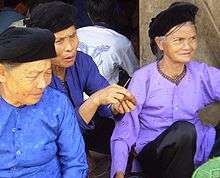Tay people
The Tày people speak a language of the Central Tai language group, and live in northern Vietnam. They are sometimes also called Thô, T'o, Tai Tho, Ngan, Phen, Thu Lao, or Pa Di.
 Tay women | |
| Total population | |
|---|---|
| 1,845,492 (2019)[1] | |
| Regions with significant populations | |
| Northern Vietnam: Cao Bằng, Lạng Sơn, Bắc Kạn, Thái Nguyên, Quảng Ninh, Bắc Ninh, Bắc Giang Provinces | |
| Languages | |
| Vietnamese • Tày | |
| Religion | |
| Then,[2] Buddhism[3] |

There are about 1.7 million Tày people living in Vietnam (based on the 2009 census and 5 years of population growth). This makes them the second largest ethnic group in Vietnam after the majority Viet ethnic group. Most are in northern Vietnam in particular in the Cao Bằng, Lạng Sơn, Bắc Kạn, Thái Nguyên, and Quảng Ninh Provinces, where they live along the valleys and the lower slopes of the mountains. They also live in some regions of the Bắc Ninh and Bắc Giang provinces. They inhabit fertile plains and are generally agriculturalists, mainly cultivating rice. They also cultivate maize, and sweet potato among other things.
Tày villages are usually based at the feet of mountains and are often named after a mountain, field or river. Each village has about 15-20 households.
Because of their historical close proximity with the majority Viet, the Tày and Viet have some mutual influences with regards to arts and religion.[5]
The Tày are closely related to the Nùng and the San Chay in Vietnam and the Zhuang on the Chinese side of the Vietnamese-Chinese border.
Religion
| Tay people | |
|---|---|
| Vietnamese name | |
| Vietnamese | Người Tày |
| Hán-Nôm | 𠊚齊 |
The majority of the Tay practices Then, an indigenous religion involving the worship of tutelary gods, gods of the natural environment, and ancestors and progenitors of human groups.[2] The patterns of this religion are inherited from Taoism and the Chinese folk religion: the god of the universe is the Jade Emperor,[2] in some local traditions (for example in the Quảng Hoà district of Cao Bằng) also identified as the Yellow Emperor (Hoàng Đế).[2] For their religious ceremonies they used to be able to recite Chinese characters but now along with the characters they use glosses because many of them can't recite anymore due to the fact that Vietnam schools don't teach Chinese characters.[6]
An altar for the ancestors is usually placed in a central location in the house. The altar room is considered sacred; guests and women who have given birth are not allowed to sit on the bed in front of the altar.
Some Tay have adopted Mahayana Buddhism under the influence of Vietnamese and Chinese culture.[3]
Language
The Tay people speak the Tày language, among other Tai dialects of the Kra–Dai languages. Literacy in their own language is quite low among Tày people, probably around 5% or less. Dialects include Central Tày, Eastern Tày, Southern Tày, Northern Tày, Tày Trung Khanh, Thu Lao, and Tày Bao Lac. There is a continuum of dialects to southern Zhuang in China.
Notable Tày people
- Hoàng Văn Thụ, General Secretary of the Indochina Communist Party.
- Nông Đức Mạnh, General Secretary of the Communist Party of Vietnam from April 22, 2001 to January 19, 2011.
- Hoàng Đức Triều, pen name An Định, a communist and poet, who worked with Ho Chi Minh.
- Hoàng Thị Tuân, representative in the Twelfth Việtnamese National Assembly.
- Lê Thế Khanh is likely the first Vietnamese poet writing in the Chinese language with his poem "Cố Hương Từ".
- Bế Văn Phụng, Tư Thiên Quản Nhạc Madarin of the Mạc reign who modified Theng music into a kind of imperial music; author of lượn "Tam Nguyên".
- Nông Quỳnh Vân, author of lượn "Hồng Nhan Tứ Qúy".
- Hoàng Đức Hậu, a famous poet composing the first of two parallel line of verse that nobody can't make the second one.
- Nông Quốc Chấn, a famous poet.
- Nông Văn Dền, alias Kim Đồng, is one of five first unionist of Ho Chi Minh Young Pioneer Union (a children's organization of Communist Party of Vietnam).
- Nông Văn Phách alias Vũ Lập, is one of beloved hero during the war against Cambodian. He was one of the most successor to guard the north border of Vietnam to prevent china invade. However, with his skill in battles and diplomacy, he didn't need to use force but he kept the Viet-China border clear. He died later because of illness. The whole north region of Vietnam mourns his death.
- La Văn Cầu, a military hero in the war of resistance against French colonial rule.
- Bế Văn Đàn, a military hero in the war of resistance against French colonial rule.
- Phùng Thanh Độ, a famous streamer.
Festival
- Lồng tồng (literally: "Going down the rice paddy") celebrated after the New Lunar Year Festival to pray for a good harvest.
- Tăm khảu mảu (literally: "Braying the young rice") celebrated as the rice is ripening.
Cuisine
- Dishes in "Slip Sli" festival (the monday of the 7th lunar month): pẻng cuội banana cake), pẻng nhứa cáy, pẻng ngá (peanut cake), pẻng mịt, pẻng tải (literally: carrying cake)
- Pẻng rày (ant's egg cake): made from glutinous rice (tay language: khảu), ant's black egg (tay language: rày) and wrapped by leaves of a kind of fig (tay language: bâu ngỏa).
- Pẻng đắng (literally: ash water cake): for Double Fifth Festival.
- Khảu thuy: is the cake for offering God and the Earth in Lồng tồng festival. Glutinous rice which is soaked in water of common water hyacinth and red flower- sandbox tree ash is mixed with taro and a kind of wine. Then, it is boiled and brayed. The next step is that it is cut into square-shaped or canarium fruit-shaped pieces and dried in the sun later. When the festival is going to come, it is fried until it is swelled. At last, it is soaked in molasses and then in fried-rice powder.
- Nà Giàng khảu sli: the glutinous cake with peanuts made in Nà Giàng, Phù Ngọc commune, Hà Quảng district, Cao Bằng Province.
- Pẻng hó: glutinous rice cake with pork and mung bean.
- Coóng phù
- Pẻng khạ (God's cake) for New Year festival.
- Khảu nua nàng tô: glutinous rice with grub for New Rice Festival on the moonday of 8th lunar month.
- Pẻng phạ: for Lồng Tồng Festival.
- Áp chao
- Pẻng chì
- Khảu slec
- Pẻng khua (smiling cake)
- Coóc mò
- Ửng sệch phàn
- Đăm đeng
- Khảu lang
- Pẻng toóc: for New Year Festival
- Pẻng cao
- Mác lịch: Trùng Khánh chestnut
- Ché khôm: Cao Bằng bitter tea: Ilex kaushue (synonym: Ilex kudingcha)
- Khau rả: Ampelopsis cantoniensis
Herbs
- Mác mật: Clausena excavata
Music
- Tính then: is a string instrument with two or three strings.
Tay-ized Vietnamese among the Tay
A part of the modern-day Tay population encompasses Tay-ized Vietnamese who live mainly in what is now Lang Son. These Tay-ized Vietnamese have their origins traced back to the Vietnamese living further south in the deltas of the Ca, Ma, and Red Rivers, e.g. Nghe An, Nam Dinh, etc. dispatched to the Sino-Annamese border by Annamese imperial governments to serve as governmental officials and local leaders (phiên thần thổ ty).[8] These people were then forbidden to return to their home areas.[8] Eventually they got assimilated into the indigenous Tay surrounding population. Their common surnames include Vi, Nguyễn Đình, Nguyễn Khắc, Nguyễn Công, Hoàng Đức, Hoàng Đình, etc. This practice started in the 15th century and ended in the early 20th century. Vi Văn Định is an example of these Tay-ized Vietnamese in the 20th century.[9]
References
- "Report on Results of the 2019 Census". General Statistics Office of Vietnam. Retrieved 1 May 2020.
- Nguyễn Thị Yên. "An Investigation into Objects of Worship in Then belief". Religious Studies Review, No. 3, Vol. 2 – October 2008
- VieTimes - Thầy Tào và câu chuyện thần linh người Tày của A Sáng Archived 2008-05-12 at the Wayback Machine
- "The 2009 Vietnam Population and Housing Census: Completed Results". General Statistics Office of Vietnam: Central Population and Housing Census Steering Committee. June 2010. Retrieved 26 November 2013.
- "Tay people in Vietnam".
- David Holm (1 February 2013). Mapping the Old Zhuang Character Script: A Vernacular Writing System from Southern China. BRILL. pp. 781–. ISBN 978-90-04-24216-6.
- Hoàng Triều Ân, Tự điển chữ Nôm Tày [Nom of the Tay People], 2003, p. 178.
Detailed information: V+63830", Vietnamese Nôm Preservation Foundation.
Father Trần Văn Kiệm, Giúp đọc Nôm và Hán Việt [Help with Nom and Sino-Vietnamese], 2004, p. 424, "Entry giàu."
Entry giàu", VDict.com. - Nguyễn Quang Huynh (2011), Thổ ty Lạng Sơn trong lịch sử, Văn hóa dân tộc publisher, p. 10.
- Văn nghệ Công nhân, KHÁNH THÀNH NHÀ THỜ TỔ HỌ VI (2017).
